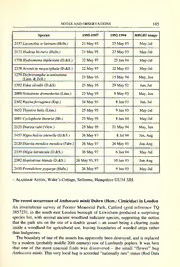
The recent occurrence of Anthocoris minki Dohrn (Hem.: Cimicidae) in London PDF
Preview The recent occurrence of Anthocoris minki Dohrn (Hem.: Cimicidae) in London
I NOTESANDOBSERVATIONS 185 Species 1995-1997 1992-1994 MBGBIimago 2157Lacanobiaw-latinum(Hufn.) 21 May95 25May93 May-Jul 2173Hadenabicruris(Hufn.) 21 May95 27May93 May-Jul 1778Hydriomenaimpluviata(D.&S.) 22May97 23Jun94 May-Jul 2278Acronictamegacephala(D.&S.) 22May97 22May93 May-Jul 1 /yl^lLflfU&fi*iFlyfltltlLlAitllrlLllLlflLi 23May95 15 May94 May,Jun (Lien. Zell.) 1392UdeaoHvalis(D.&S) 23May95 29May92 Jun,Jul 2000Notodontadromedarius(Linn.) 23May95 9May93 May,Jun 2302Rusinaferruginea(Esp.) 24May95 8Jun93 Jun,Jul 1652Thyatirabatis(Linn.) 25May95 9Jun93 May-Jul 1681 Cyclophoralinearia(Hb.) 25 May95 8Jun94 May-Jul 2123Diarsiarubi(View.) 25 May95 21 May94 May,Jun 1457Hypochalciaahenella(D.&S.) 26May97 8Jul94 Jun,Aug 2120Diarsiamendicamendica(Fabr.) 26May97 26May93 Jun-Aug 2339Oligialatruncula(D.&S.) 26May97 6Jun94 May-Jul 2382Hoplodrinablanda(D.&S.) 26May95,97 10Jun93 Jun-Aug 2410Protodeltotepygarga(Hufn.) 26May97 9Jun93 May-Jul -AlasdairAston,Wake's Cottage, Selbome, HampshireGU343JH. TherecentoccurrenceofAnthocorisminkiDohrn (Hem.: Cimicidae) in London An invertebrate survey of Forster Memorial Park, Catford (grid reference TQ 385723), in the south-east London borough of Lewisham produced a surprising species list, with several ancient woodland indicator species, supporting the notion that the park sits on the site of a double assart - an assart being a clearing made inside a woodland for agricultural use, leaving boundaries of wooded strips rather thanhedgerows. The boundary ofone ofthe assarts has apparently been destroyed, and is replaced by a modem (probably middle 20th century) row ofLombardy poplars. It was here that one of the most unusual finds was discovered - the small "flower" bug Anthocoris minki. This very local bug is accorded "nationally rare" status (Red Data 186 ENTOMOLOGIST'SRECORD,VOL. 112 25.vii.2000 Book category 3) by Kirby (1992. A review of the scarce and threatened Hemiptera ofGreatBritain. Joint Nature Conservation Committee). At the time of that review it was recorded only from the Thames tow-path at Kew, and Three Locks, Soulbury, Buckinghamshire. Previous confusion over the identity of species in this difficult genus means that records before Jessop (1993. The British species of Anthocoris (Hem: Anthocoridae) Entomologist's Monthly Magazine 119: 221-223), who confirmed the bug as British, are probably referable to A. simulansRenter. There are many small (3-4 mm) chequered brown and yellow bugs in this genus. They are variously predators of aphids, psocids or other small insects. Anthocoris minkiis unusual inthat it lives insidethepeculiarspiralplantgallsmadeby its aphid prey in the leaf petioles of Lombardy poplar. The aphid which creates these characteristic galls.Pemphigusspirothecae (Passerini), is acommon andwidespread species, butthebug is apparently veryrare. Even when this close association was first recorded in Britain, by Jessop, the disparity between the aphid's widespread abundance and the bug's national scarcity was commented upon. Despite searches of apparently suitable sites, Kirby reports that the bug was not found elsewhere. The occurrence rate quoted for Kew was of the order of 2%, two of approximately 100 galls contained 5th instar Anthocoris, sevenofwhichwererearedtoadulthood. In Forster Memorial Park, Anthocoris minki was very common in the Pemphigus galls and seemingly in much greater abundance than at any of the other recorded sites. Although I did not make a detailed count, I probably examined less than 50 galls andyetfoundeightexamples ofthebug, an"infestation"rateofatleast 16%. Strangely, this was not the first time I had come across the bug. On 5 July 1998 I swept an Anthocoris in Morden Cemetery (TQ 233673) in south-west London. It seemed to work to A. minki, and it occurred near a row of Pemphigus-gaUtd Lombardy poplars, but I was not completely confident of the determination and a return visit, perhaps too late in the season, failed to find any specimens in the spiral galls. Comparison with the bugs from ForsterMemorial Park, however, confirms the identification. But even before this, I had come across a prior reference to the bug in another survey, ofLondon's Battersea Park. An unpublished reportby Sorenson etal. (1993 BatterseaPark nature areas. The nature reserve andwilderness) listsA. minki with only abriefcommentonitsrarity andnomentionofitsecology inacreditablelistof 140 insects an 40 other invertebrates. Nothing is known aboutthose carrying outthe survey, but judging from the bibliography which accompanies their report, they concentrated on the more characteristic groups and had limited access to authoritative identification guides. They found two noteworthy species, the hoverfly Volucella zonaria Poda (found again in 1998, and in fact quite common in London) and Anthocoris minki. At the time I read their report I was sceptical about the A. minkirecord,butnow Ihavedoubts aboutmydoubts anditseems quitepossiblethat the bug is established in Battersea Park also. -Richard A. Jones, 135 Friem Road, EastDulwich, London SE22OAZ. (bugmanjones(5)hotmail.com).
